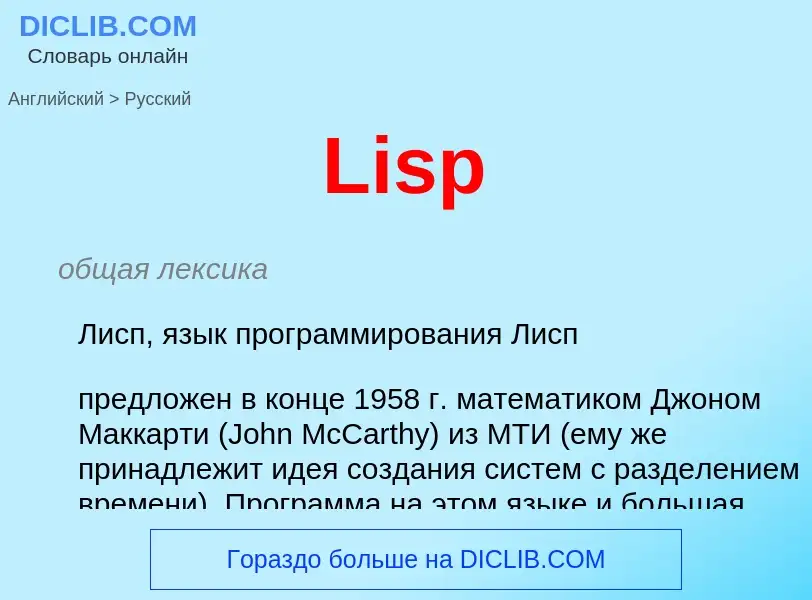Vertaling en analyse van woorden door kunstmatige intelligentie ChatGPT
Op deze pagina kunt u een gedetailleerde analyse krijgen van een woord of zin, geproduceerd met behulp van de beste kunstmatige intelligentietechnologie tot nu toe:
- hoe het woord wordt gebruikt
- gebruiksfrequentie
- het wordt vaker gebruikt in mondelinge of schriftelijke toespraken
- opties voor woordvertaling
- Gebruiksvoorbeelden (meerdere zinnen met vertaling)
- etymologie
Lisp - vertaling naar Engels
общая лексика
Лисп, язык программирования Лисп
предложен в конце 1958 г. математиком Джоном Маккарти (John McCarthy) из МТИ (ему же принадлежит идея создания систем с разделением времени). Программа на этом языке и большая часть структур данных представляют собой связанные списки. Базовыми операциями языка являются операции над списками. Это был, в частности, первый ЯВУ, в котором при работе с динамически распределяемой памятью производится автоматическая "сборка мусора" (garbage collection). Название идет от List Processing language (из-за изобилия скобок некоторыми расшифровывается как Lots of Idiotic Silly Parentheses). Язык функционального программирования, базирующийся на лямбда-исчислении. Диалекты: для PC - MuLISP фирмы Soft Warehouse, Honolulu, Havaii
INTERLISP, Common Lisp, MacLisp. Используется для задач ИИ
[lisp]
общая лексика
шепелявить
существительное
[lisp]
общая лексика
шепелявость
шёпот
лепет (волн)
шорох
шелест
лепет (волн)
шорох, шелест
глагол
общая лексика
шепелявить
лепетать (о детях)
лепетать (о детях)
Wikipedia
Lisp (historically LISP, an acronym for list processing) is a family of programming languages with a long history and a distinctive, fully parenthesized prefix notation. Originally specified in 1960, Lisp is the second-oldest high-level programming language still in common use, after Fortran. Lisp has changed since its early days, and many dialects have existed over its history. Today, the best-known general-purpose Lisp dialects are Common Lisp, Scheme, Racket and Clojure.
Lisp was originally created as a practical mathematical notation for computer programs, influenced by (though not originally derived from) the notation of Alonzo Church's lambda calculus. It quickly became a favored programming language for artificial intelligence (AI) research. As one of the earliest programming languages, Lisp pioneered many ideas in computer science, including tree data structures, automatic storage management, dynamic typing, conditionals, higher-order functions, recursion, the self-hosting compiler, and the read–eval–print loop.
The name LISP derives from "LISt Processor". Linked lists are one of Lisp's major data structures, and Lisp source code is made of lists. Thus, Lisp programs can manipulate source code as a data structure, giving rise to the macro systems that allow programmers to create new syntax or new domain-specific languages embedded in Lisp.
The interchangeability of code and data gives Lisp its instantly recognizable syntax. All program code is written as s-expressions, or parenthesized lists. A function call or syntactic form is written as a list with the function or operator's name first, and the arguments following; for instance, a function f that takes three arguments would be called as (f arg1 arg2 arg3).

![4.3 BSD]] from the [[University of Wisconsin]], displaying the [[man page]] for [[Franz Lisp]] 4.3 BSD]] from the [[University of Wisconsin]], displaying the [[man page]] for [[Franz Lisp]]](https://commons.wikimedia.org/wiki/Special:FilePath/4.3 BSD UWisc VAX Emulation Lisp Manual.png?width=200)
![A [[Lisp machine]] in the [[MIT Museum]] A [[Lisp machine]] in the [[MIT Museum]]](https://commons.wikimedia.org/wiki/Special:FilePath/LISP machine.jpg?width=200)
